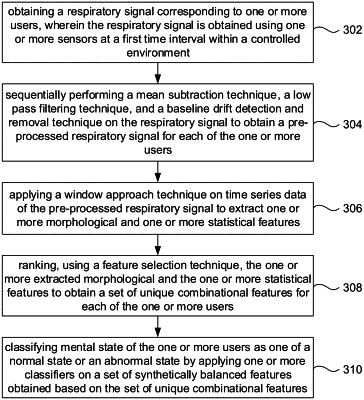| CPC A61B 5/165 (2013.01) [A61B 5/08 (2013.01); A61B 5/7225 (2013.01); A61B 5/7267 (2013.01); A61B 5/746 (2013.01); G16H 50/30 (2018.01)] | 4 Claims |

|
1. A processor implemented method for stress level monitoring of one or more users, comprising:
acquiring unobstrusively, using one of a respiration belt, a pneumotachograph, and an accelerometer, a respiratory signal corresponding to the one or more users, at a first time interval within a controlled environment;
obtaining, by one or more hardware processors via one or more communication interfaces, the respiratory signal corresponding to the one or more users;
sequentially performing, by the one or more hardware processors, a mean subtraction technique, and a low pass filtering technique on the respiratory signal to obtain an output;
performing, by the one or more hardware processors, a baseline drift detection and removal technique on the output to obtain a pre-processed respiratory signal for each of the one or more users, wherein the baseline drift detection and removal technique is applied on the output to filter baseline drift by (i) identifying one or more troughs in the output, wherein a spline is fitted through the identified one or more troughs and (ii) correcting time series data of the output, above the spline, to zero;
applying, by the one or more hardware processors, a window approach technique on the pre-processed respiratory signal to extract one or more morphological and one or more statistical features, wherein the one or more statistical features are extracted from a higher order dynamics of the pre-processed respiratory signal for each of the one or more users, wherein the window approach technique comprises a 15 seconds window, a 30 seconds window and a second 15 second window with 50% overlap, and wherein the one or more morphological features extracted from the pre-processed respiratory signal comprises inspiratory cycle, expiratory cycle, breath per minute, tidal volume, expiratory ratio, inspiratory ratio, max inspiratory flow, minimum expiratory flow, breath ratio, inspiratory volume, expiratory volume, Stretch and Minute volume;
ranking, by the one or more hardware processors, using a feature selection technique, the one or more extracted morphological and the one or more statistical features to obtain a set of unique combinational features of the statistical and morphological features, for each of the one or more users;
adjusting, by the one or more hardware processors, the set of unique combinational features using Synthetic Minority Oversampling Technique (SMOTE) to obtain a set of synthetically balanced features, wherein a dataset of the set of unique combinational features is split into a testing dataset and a training dataset to avoid high probability of same data getting repeated, and then SMOTE is applied over the training dataset for validation of the testing data set and to obtain the set of synthetically balanced features;
classifying, by the one or more hardware processors, a mental state of the one or more users as one of a normal state or an abnormal state by applying one or more classifiers on the set of synthetically balanced features;
training, by the one or more hardware processors, a model for each of the one or more users based on the mental state of the one or more users as one of the normal state or the abnormal state;
upon obtaining the trained model, obtaining, by the one or more hardware processors, the respiratory signal corresponding to the one or more users, wherein the respiratory signal is obtained at one or more time intervals for a pre-determined time period;
generating, by the one or more hardware processors, using the trained model, a stress score for each of the one or more users, wherein the stress score is generated for the pre-determined time period; and
raising, by the one or more hardware processors, an alarm in response to the stress score, to alert the one or more users associated thereof, thereby providing continuous feedback to the one or more users about the mental state and in turn help the one or more users to control their stress levels.
|